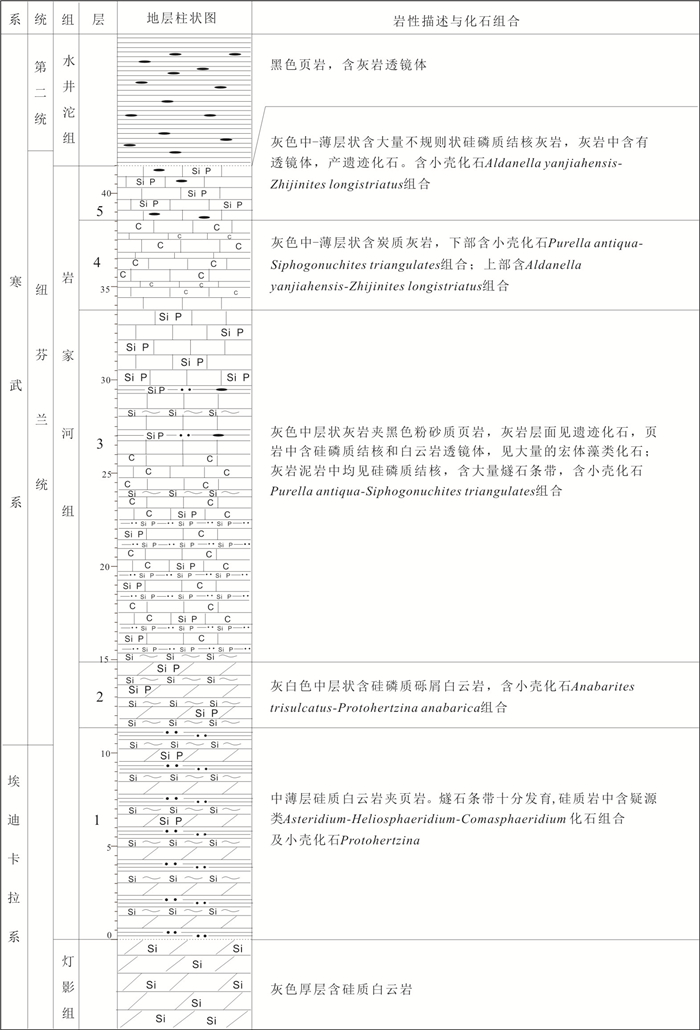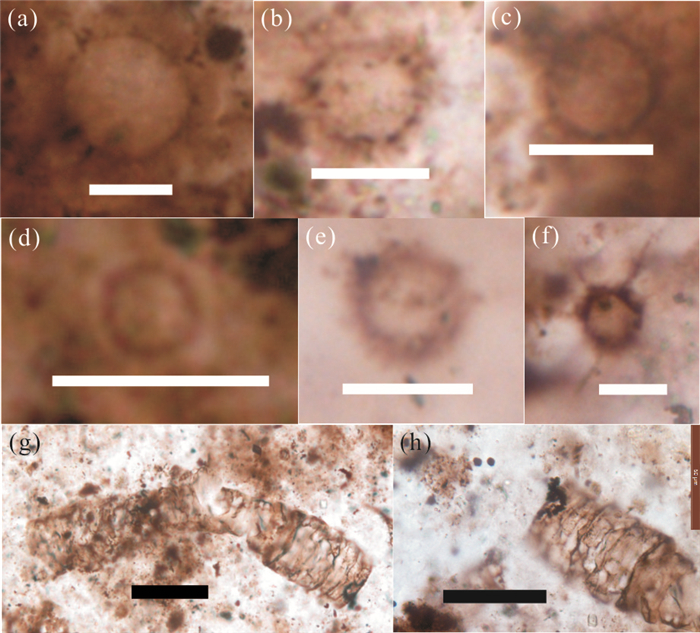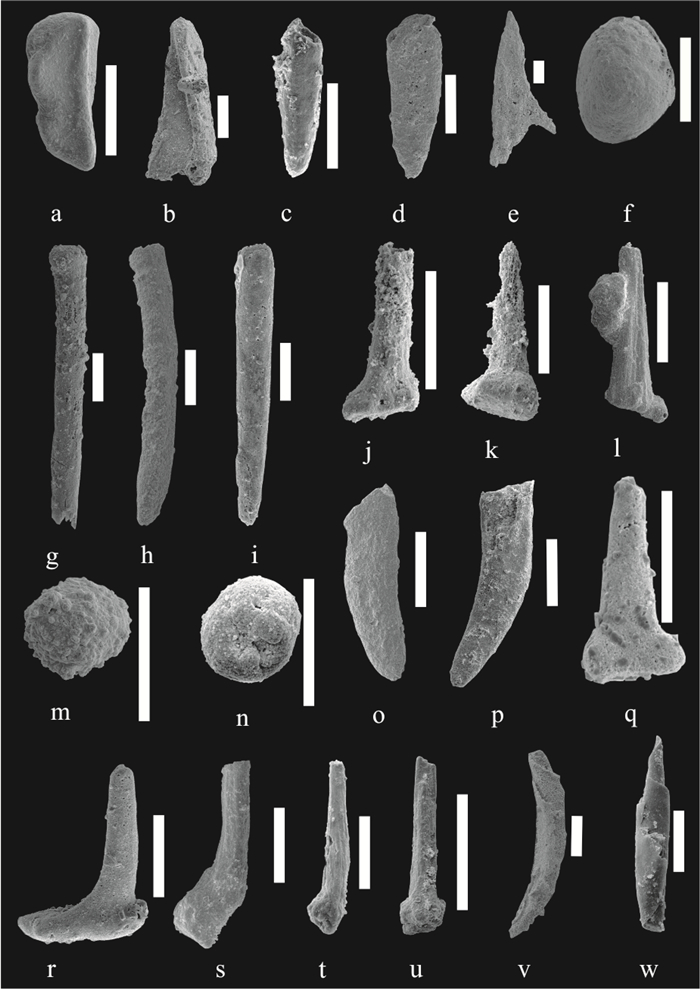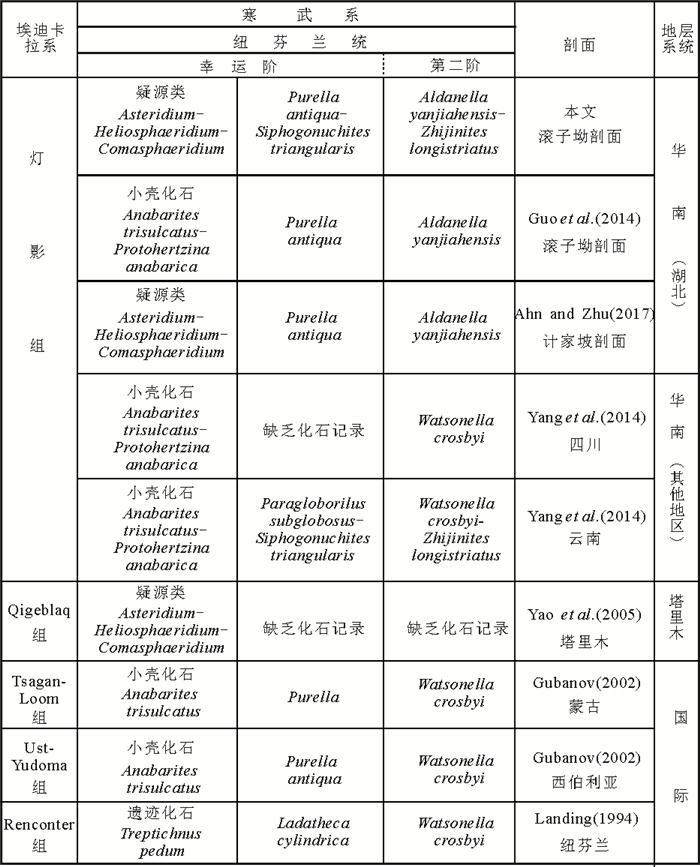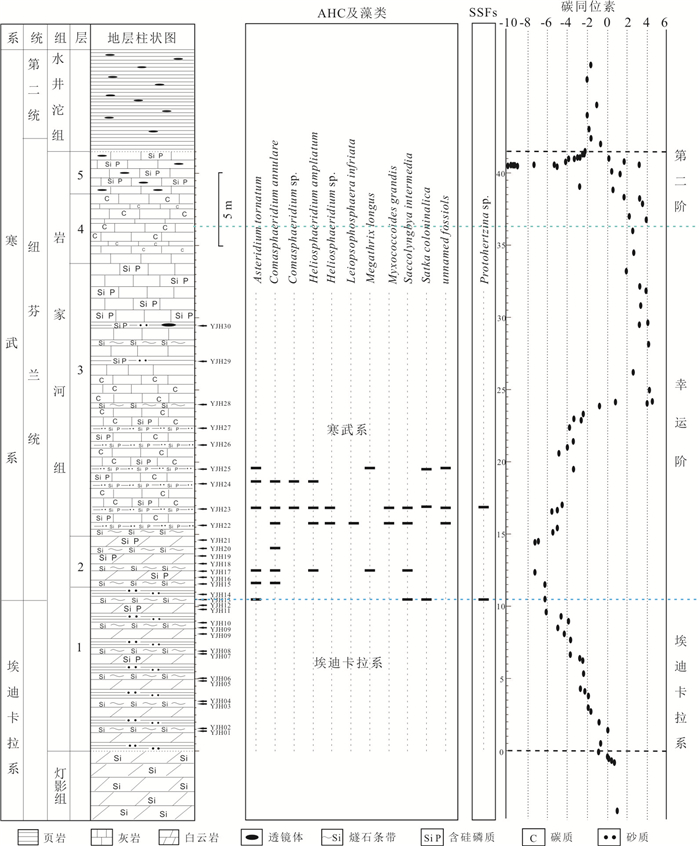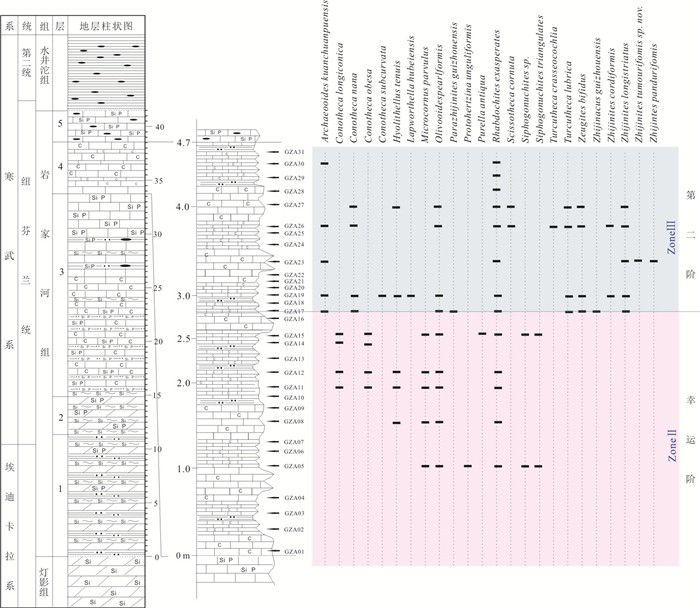Lower and Upper Boundaries of Fortunian from Yichang, Hubei, China
-
摘要: 对湖北宜昌地区滚子坳剖面寒武系纽芬兰统幸运阶顶底界线的位置进行较为细致的研究.通过切片法及酸蚀法对61个样品进行系统处理,获得了大量的小壳化石、疑源类化石及其他分类位置未定化石.系统鉴定和描述了23属44种.根据具刺疑源类化石Asteridium和小壳化石Protohertzina sp.的首现位置以及无机碳同位素BACE曲线最大负值位置可以推断出埃迪卡拉系-寒武系界线应该位于第1层底部往上约10.5 m处;根据Zhijinites longistriatus的首现位置以及无机碳同位素ZHUCE曲线最大值位置可以推断出幸运阶与第二阶的界线位置大致为第4层底部往上约2.78 m.此外,还将峡东地区的小壳化石Ⅱ带和Ⅲ带重新定义,即将Purella antiqua组合(Zone Ⅱ)修订为Purella antiqua-Siphogonuchites triangularis组合;将Aldanella yanjiahensis组合(Zone Ⅲ)修订为Aldanella yanjiahensis-Zhijiniteslongistriatus组合.Abstract: This paper is focused on the base of the Fortunian and Cambrian Stage 2 in the Gunziao section of Yichang, Hubei province. Thousands of SSFs has been found by dealing with 61 samples, 23 genera and 44 species to be identified and described. Additionally, some conclusions are drawn as follows. According to the first appearance datum of Asteridium and Protohertzina sp., and the large negative carbon isotope anomaly (BACE), the base of the Fortunian should be located at 10.5 meters above the Beds 1. According to the first appearance datum of Zhijinites longistriatus and the large positive carbon isotope anomaly (ZHUCE), it can be inferred that the base of Stage 2 is approximately 2.78 meters above the Beds 4. Purella antiqua Assemblage Zone (ZoneⅡ) and Aldanella yanjiahensis Assemblage Zone (ZoneⅢ) in Three Gorge area are redefined based on the new data, which is to be Purella antiqua-Siphogonuchites triangularis Assemblage Zone and Aldanella yanjiahensis-Zhijinites longistriatus Assemblage Zone.
-
Key words:
- Cambrian /
- Fortunian Stage 2 /
- small shelly fossils /
- AHC assemblage zone /
- Gunziao section /
-
图 3 湖北宜昌滚子坳剖面纽芬兰统岩家河组疑源类化石及其共生化石
a~c. Asteridium tornatum,内视图;d~e. Comasphaeridium annulare,内视图;f. Heliosphaeridium ampliatum,内视图;g~h. Megathrix longus,纵切面;图f引自Chang et al.(2019); 比例尺a~f为10 μm,g~h为50 μm
Fig. 3. The acritarchs and paragenetic fossils from Yanjiahe Formation of Gunziao section in Yichang, Hubei Province
图 4 湖北宜昌滚子坳剖面纽芬兰统岩家河组小壳化石ZoneⅡ
比例尺=100 μm; a~i为ZoneⅡ,j~w为ZoneⅢ;a~b. Siphogonuchitestriangularis,a.凹面视,b.侧视;c~d. Microcornus parvulus,侧视;e. Protohertzina unguliformis,侧视;f.Purella antiqua,顶视;g~i. Conotheca longiconica,侧视;j~k. Zhijinites longistriatus,侧视;m~n. Archaeooides sp.,外视;o~p. Turcutheca lubrica,侧视;q. Zhijinites cordiformis,侧视;r. Zhijinacus guizhouensis,侧视;s. Zhijintes pandurifomis,侧视;l, t~u. Zhijinites tumourifomis,侧视;v~w. Lapworthella hubeiensis,侧视;其中j~l, q~u潘时妹等(2018)
Fig. 4. The small selly fossils from Yanjiahe Formation of the Gunziao section in Yichang, Hubei Province
图 6 湖北宜昌滚子坳剖面埃迪卡拉系-寒武系界线附近主要化石分布及无机碳同位素曲线
1.无机碳同位素图修改自(Ishikawa et al., 2008); 2.寒武系底界置于BACE负异常什么位置目前国际上无定论,本文有大量化石,根据化石的指示将BACE负值的峰值作为寒武系底界,第二阶底界的定义同理
Fig. 6. Distribution of fossils and inorganic carbon isotope curves near the Ediacaran-Cambrian boundary line in the Gunziao section of Yichang, Hubei Province
-
Ahn, S. Y., Zhu, M. Y., 2017. Lowermost Cambrian Acritarchs from the Yanjiahe Formation, South China: Implication for Defining the Base of the Cambrian in the Yangtze Platform. Geological Magazine, 154(6): 1217-1231. https://doi.org/10.1017/s0016756816001369 An, Z., Tong, J., Xu, C., et al., 2018. Stratigraphic Division and Correlation of Ediacaran Doushantuo Formation in Zhangcunping Area, Yichang, Hubei Province. Earth Sciences, 43(7):2206-2221 (in Chinese with English abstract). http://en.cnki.com.cn/Article_en/CJFDTotal-DQKX201807002.htm Babcock, L. E., Peng, S. C., Zhu, M. Y., et al., 2014. Proposed Reassessment of the Cambrian GSSP. Journal of African Earth Sciences, 98: 3-10. https://doi.org/10.1016/j.jafrearsci.2014.06.023 Babcock, L. E., Peng, S. C., Geyef, G., et al., 2005. Changing Perspectives on Cambrian Chronostratigraphy and Progress Toward Subdivision of the Cambrian System. Geosciences Journal, 9(2): 101-106. https://doi.org/10.1007/bf02910572 Brasier, M., Cowie, J., Taylor, M., 1994. Decision on the Precambrian-Cambrian Boundary Stratotype. Episodes, 17(1/2): 3-8. https://doi.org/10.18814/epiiugs/1994/v17i1.2/002 Chang, S., Lei, Z., Sébastien, C., et al., 2019. The Ediacaran-Cambrian Rise of Siliceous Sponges and Development of Modern Oceanic Ecosystems. Precambri-an Research, 333: 105438. doi: 10.1016/j.precamres.2019.105438 Cowie, J. W., Glaessner, M. F., 1975. The Precambrian-Cambrian Boundary: A Symposium. Earth-Science Reviews, 11(3): 209-251. https://doi.org/10.1016/0012-8252(75)90120-8 Cowie, J.W., Ziegker, W., Boucot, A.J., et al., 1986. Guidelines and Status of the International Commission on Stratigraphy Courier Forsch. Cour Forsch-Inst Senckenberg, 83:1-14. http://www.schweizerbart.de/publications/detail/artno/190308300 Da, L.I., Ling, H.F., Jiang, S.Y., et al., 2009. New Carbon Isotope Stratigraphy of the Ediacaran-Cambrian Boundary Interval from SW China: Implications for Global Correlation. Geological Magazine, 146(4): 465-484. https://doi.org/10.1017/s0016756809006268 Dong, L., Xiao, S. H., Shen, B., et al., 2009. Basal Cambrian Microfossils from the Yangtze Gorges Area (South China) and the Aksu Area (Tarim Block, Northwestern China). Journal of Paleontology, 83(1): 30-44. https://doi.org/10.1666/07-147r.1 Fu, D. J., Tong, G. H., Dai, T., et al., 2019. The Qingjiang Biota:A Burgess Shale-Type Fossil Lagerstätte from the Early Cambrian of South China. Science, 363(6433): 1338-1342. https://doi.org/10.1126/science.aau8800 Guo, J., 2009.Yanjiahe Biota from the Early Cambrian of Yichang, Hubei, China(Dissertation). Northwest University, Xi'an, 1-158 (in Chinese with English abstract). Guo, J. F., Li, Y., Li, G. X., 2014. Small Shelly Fossils from the Early Cambrian Yanjiahe Formation, Yichang, Hubei, China. Gondwana Research, 25(3): 999-1007. https://doi.org/10.1016/j.gr.2013.03.007 Ishikawa, T., Ueno, Y., Komiya, T., et al., 2008. Carbon Isotope Chemostratigraphy of a Precambrian-Cambrian Boundary Section in the Three Gorge Area, South China: Prominent Global-Scale Isotope Excursions just before the Cambrian Explosion. Gondwana Research, 14(1):193-208. http://www.sciencedirect.com/science/article/pii/S1342937X07001979 Jacquet, S. M., Brougham, T., Skovsted, C. B., et al., 2016. Watsonella Crosbyi from the Lower Cambrian (Terreneuvian, Stage 2) Normanville Group in South Australia. Geological Magazine, 154(5): 1088-1104. https://doi.org/10.1017/s0016756816000704 Khomentovsky, V. V., Karlova, G. A., 1993. Biostratigraphy of the Vendian-Cambrian Beds and the Lower Cambrian Boundary in Siberia. Geological Magazine, 130(1): 29-45. https://doi.org/10.1017/s0016756800023700 Landing, E., Peng, S. C., Babcock, L. E., et al., 2007. Global Standard Names for the Lowermost Cambrian Series and Stage. Episodes, 30(4): 287-289. https://doi.org/10.18814/epiiugs/2007/v30i4/004 Landing, E., Geyer, G., Brasier, M. D., et al., 2013. Cambrian Evolutionary Radiation: Context, Correlation, and Chronostratigraphy:Overcoming Deficiencies of the First Appearance Datum (FAD) Concept. Earth-Science Reviews, 123: 133-172. https://doi.org/10.1016/j.earscirev.2013.03.008 Landing, E., Kruse, P. D., 2017. Integrated Stratigraphic, Geochemical, and Paleontological Late Ediacaran to Early Cambrian Records from Southwestern Mongolia: Comment. Geological Society of America Bulletin, 129(7/8): 1012-1015. https://doi.org/10.1130/b31640.1 Landing, E., 1994. Precambrian-Cambrian Boundary Global Stratotype Ratified and a New Perspective of Cambrian Time. Geology, 22(2): 179. https://doi.org/10.1130/0091-7613(1994)022<0179:pcbgsr>2.3.co;2 doi: 10.1130/0091-7613(1994)022<0179:pcbgsr>2.3.co;2 Li, D., Ling, H. F., Jiang, S. Y., et al., 2009. New Carbon Isotope Stratigraphy of the Ediacaran-Cambrian Boundary Interval from SW China: Implications for Global Correlation. Geological Magazine, 146(4): 465-484. https://doi.org/10.1017/s0016756809006268 Li, D., Ling, H. F., Shields-Zhou, G. A., et al., 2013. Carbon and Strontium Isotope Evolution of Seawater Across the Ediacaran-Cambrian Transition: Evidence from the Xiaotan Section, NE Yunnan, South China. Precambrian Research, 225: 128-147. https://doi.org/10.1016/j.precamres.2012.01.002 Li, G. X., Steiner, M., Zhu, X. J., et al., 2007. Early Cambrian Metazoan Fossil Record of South China: Generic Diversity and Radiation Patterns. Palaeogeography, Palaeoclimatology, Palaeoecology, 254(1/2): 229-249. https://doi.org/10.1016/j.palaeo.2007.03.017 Li, G. X., Zhao, X., Gubanov, A., et al., 2011. Early Cambrian Mollusc Watsonella Crosbyi: A Potential GSSP Index Fossil for the Base of the Cambrian Stage 2. Acta Geologica Sinica-English Edition, 85(2): 309-319. https://doi.org/10.1111/j.1755-6724.2011.00400.x Luo, H., Jiang, Z., Xu, C., et al., 1980. On the Sinian-Cambrian Boundary of Meishucun and Wangjiawan, Jinning County, Yunnan. Acta Geologica Sinica, (2):13-85 (in Chinese with English abstract). http://en.cnki.com.cn/Article_en/CJFDTOTAL-DZXE198002001.htm Moczydlowska, M., 1991. Acritarch Biozonation and Regional Correlation of the Lower Cambrian. Geologiska Föreningen i Stockholm Förhandlingar, 113(1): 87-87. https://doi.org/10.1080/11035899109453834 Pan, S.M., Feng, Q.L., Chang, S., 2018. Small shelly fossils from the Terreneuvian Yanjiahe Formation, Yichang, Hubei, China. Acta Micropalaeontologica Sinica, 35(1):30-40 (in Chinese with English abstract). Peng, S., 2006. New Global Subdivision on Cambrian Chronostratigraphy. China Academic Journal Electronic Publishing House, 21(4):325-328 (in Chinese with English abstract). http://en.cnki.com.cn/Article_en/CJFDTOTAL-KYYX200604018.htm Peng, S., 2004. Suggested Global Subdivision of Cambrian System and Two Potential GSSPs in Hunan, China for defining Cambrian stages. Lethaia, 37:365-379. doi: 10.1080/00241160410002081 Qian, Y., He, T., 1996. New investigation of Precambrian-Cambrian Boundary Sections in Eastern Yunnan. Acta Micropalaeontologica Sinica, 36(1):21-30 (in Chinese with English abstract). http://europepmc.org/abstract/cba/294023 Steiner, M., Li, G. X., Qian, Y., et al., 2007. Neoproterozoic to Early Cambrian Small Shelly Fossil Assemblages and a Revised Biostratigraphic Correlation of the Yangtze Platform (China). Palaeogeography, Palaeoclimatology, Palaeoecology, 254(1/2): 67-99. https://doi.org/10.1016/j.palaeo.2007.03.046 Wang, D., Ling, H.F., Li, D., et al., 2012. Carbon Isotope Stratigraphy of Yanjiahe Formation across the Ediacaran-Cambrian Boundary in the Area of the Three Gorges. Journal of Stratigraphy, 36(1):21-30 (in Chinese with English abstract). http://en.cnki.com.cn/Article_en/CJFDTOTAL-DCXZ201201004.htm Wang, X.F., Ni, S.Z., Zeng, Q.L., 1987. Biostratigraphy in the Three Gorges Area of the Yangtze River (2), Early Paleozoic Volume. Geological Publishing House, Beijing, 43-143 (in Chinese) Yang, B., Steiner, M., Li.G., et al., 2014a. Terreneuvian Small Shelly Faunas of East Yunnan (South China) and Their Biostratigraphic Implications. Palaeogeography Palaeoclimatology Palaeoecology, 398:28-58. doi: 10.1016/j.palaeo.2013.07.003 Yang, B., Steiner, M., Zhu, M. Y., et al., 2014b. Transitional Ediacaran-Cambrian Small Skeletal Fossil Assemblages from South China and Kazakhstan: Implications for Chronostratigraphy and Metazoan Evolution. Precambrian Research, 285: 202-215. https://doi.org/10.1016/j.precamres.2016.09.016 Yao, J., Xiao, S., Yin, L., et al., 2005. Basal Cambrian Microfossils from the Yurtus and Xishanblaq Formations (Tarim, North-West China): Systematic Revision and Biostratigraphic Correlation of Micrhystridium-Like Acritarchs. Palaeontology, 48(4): 687-708. https://doi.org/10.1111/j.1475-4983.2005.00484.x Yi, Q., Yan, Z.M., Xiang, L.G., et al., 2002. A Supplemental Precambrian-Cambrian Boundary Global Stratotype Section in Southwest China. Acta Palaeontologica Sinica, 35(35): 165-185. http://europepmc.org/abstract/cba/368400 Zhu, M., Yang, A., Yuan, J., et al., 2019. Cambrian Integrative Stratigraphy and Timescale of China. Science China Earth Sciences, 49(1): 26-65 (in Chinese with English abstract). http://www.cqvip.com/QK/60111X/20191/6100172027.html Zhu, M. Y., Babcock, L. E., Peng, S. C., 2006. Advances in Cambrian Stratigraphy and Paleontology: Integrating Correlation Techniques, Paleobiology, Taphonomy and Paleoenvironmental Reconstruction. Palaeoworld, 15(3/4): 217-222. https://doi.org/10.1016/j.palwor.2006.10.016 Zhu, M. Y., Strauss, H., Shields, G. A., 2007. From Snowball Earth to the Cambrian Bioradiation: Calibration of Ediacaran-Cambrian Earth History in South China. Palaeogeography, Palaeoclimatology, Palaeoecology, 254(1/2): 1-6. https://doi.org/10.1016/j.palaeo.2007.03.026 Zhu, M., Zhuravlev, A. Y., Wood, R. A., et al., 2017. A Deep Root for the Cambrian Explosion: Implications of New Bio- and Chemostratigraphy from the Siberian Platform. Geology, 45(5): 459-462. https://doi.org/10.1130/g38865.1 安志辉, 童金南, 叶琴, 等, 2018.湖北宜昌樟村坪地区陡山沱组地层划分与对比.地球科学, 43(7):2206-2221. doi: 10.3799/dqkx.2018.155 郭俊锋, 2009.湖北宜昌早寒武世岩家河生物群研究(博士学位论文).西安: 西北大学, 1-158. 罗惠麟, 蒋志文, 徐重九, 等, 1980.云南晋宁梅树村、王家湾震旦系-寒武系界线研究.地质学报, (2):13-85. https://www.cnki.com.cn/Article/CJFDTOTAL-DZXE198002001.htm 潘时妹, 冯庆来, 常珊, 2018.湖北宜昌寒武系纽芬兰统岩家河组小壳化石.微体古生物学报, 35(1):30-40. https://www.cnki.com.cn/Article/CJFDTOTAL-WSGT201801003.htm 彭善池, 2006.全球寒武系年代地层新划分.中国科学院院刊, 21(4):325-328. doi: 10.3969/j.issn.1000-3045.2006.04.019 钱逸, 何廷贵, 1996.再论滇东前寒武系与寒武系界线剖面.微体古生物学报, (3): 225-240. https://www.cnki.com.cn/Article/CJFDTOTAL-WSGT603.002.htm 王丹, 凌洪飞, 李达, 等, 2012.三峡地区岩家河埃迪卡拉系-寒武系界线剖面碳同位素地层学研究.地层学杂志, 36(1):21-30. https://www.cnki.com.cn/Article/CJFDTOTAL-DCXZ201201004.htm 汪啸风, 倪世钊, 曾庆銮, 1987.长江三峡地区生物地层学.北京:地质出版社, 43-137. 朱茂炎, 杨爱华, 袁金良, 等, 2019.中国寒武纪综合地层和时间框架.中国科学:地球科学, 49(1): 26-65. https://www.cnki.com.cn/Article/CJFDTOTAL-JDXK201901004.htm -










 下载:
下载:
